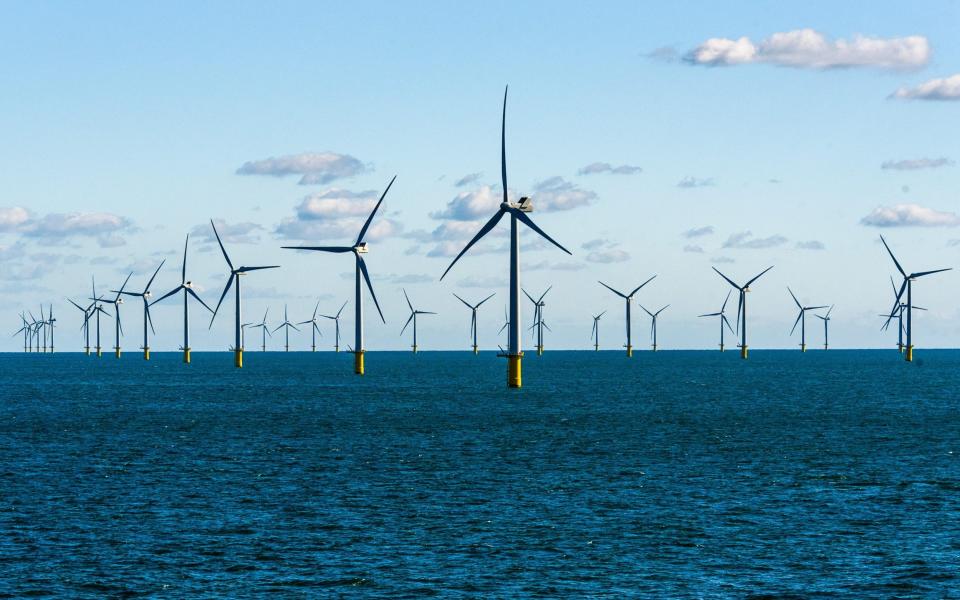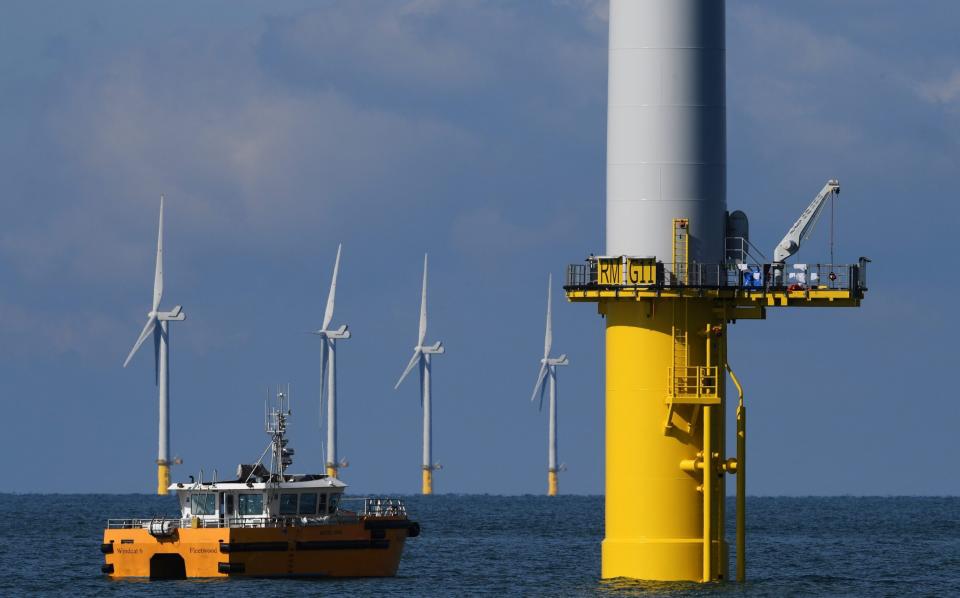How past mistakes are forcing us to pay too much for green power

From the Sussex coast ten miles away, the matchstick frames of the Rampion wind farm’s turbines gently interrupt the blue block of sea and sky.
Up close, their industrial strength is clear: 140 metres tall, with blades spanning 112 metres across, weighed on to the sea-floor with 800-tonne steel foundations. If the wind is good, they can supply roughly 350,000 homes, more than the population of nearby Brighton.
Opened in 2018 by the German energy giant E.ON, the farm was the first to be built in the south of England, part of the ongoing boom in renewable power that is helping to slash UK carbon emissions.
Local opponents, raising the alarm over harm to fish, birds and the view, were won over or sidelined in the pursuit of the bigger goal of green energy.
Today, the people of Sussex have another reason to eye the turbines with a little anger: wind farms are raking in an increasing proportion of their cash.
Vladimir Putin’s war in Ukraine, as well as problems with France’s nuclear fleet, have triggered shortages of gas and electricity across Europe. The scarcity has pushed up the price of both.
In the UK and other countries in Europe, market design makes matters worse. The price of electricity is tied to the price of gas, which is delivering extra pain for households but huge margins for wind farms, whose revenues have leapt while their costs have not.
While families across the country have faced a near doubling in annual energy bills to £2,500, producers’ profits are up.
RWE, the Germany energy giant which now owns Rampion, made €859m profits from offshore wind in the first three quarters of 2022, up from €656m last year. Scottish Power, owned by Spain’s Iberdrola, saw profits from its renewables climb from £184.5m to £263.4m in the six months to the end of June.
Profits at EDF’s renewables division, which owns several UK wind farms, climbed 70pc to €500m over the first half of the year.. Better wind speeds and in some cases new projects have also helped, but the impact of rising electricity prices is clear.
Households can be forgiven for feeling hard done to. For many years, ministers have talked up the falling costs of wind power and its growth as a power source. Wind now provides 20pc of Britain’s electricity. Yet households are increasingly asking: why are my bills so high, if the wind and the sun are providing more of my electricity?
This issue lies in the so-called “pay-as-clear” system that dictates the UK’s market. Under the arrangement, the price of electricity is set by the most expensive source picked to meet demand. In the UK market at the moment, that means gas-fired generation.
This is not an unusual set up. Ed Birkett, head of energy and climate at think-tank Onward, says: “That is the system that we have in the electricity sector, but also in all sorts of other commodity markets."
Supporters argue it improves transparency and efficiency, as producers are encouraged to set their prices at a level which means they will be picked.

University College London estimates that gas has set electricity costs 84pc of the time in recent years, despite supplying less than half of the nation’s electricity. Gas prices have climbed five or six-fold as Russia strangles supplies to Europe, pushing up electricity in tandem.
“If we actually paid the average price of what our electricity now costs to produce, our bills would be substantially cheaper,” argued UCL’s Professor Michael Grubb in September.
This week Jeremy Hunt, the chancellor, moved to claw back some of those profits to help the state raise billions for subsidising soaring energy bills. He introduced a £45bn levy on electricity sold at over £75 per megawatt-hour. Pre-crisis prices were around £50 per megawatt-hour, but have soared above £400 since Russia’s war on Ukraine.
“The structure of our energy market [..] creates windfall profits for low-carbon electricity generation,” Mr Hunt said.
It is the older wind farms in the UK that are in line for the fattest profits. Before 2017, wind farm developers took their own risk on prices, gambling that they could sell the electricity generated at a high enough price to make the venture worth it. Operators were incentivised to get into the market with hefty subsidies, which they still receive.
In the current market, that means these older wind farms are reaping high wholesale rates on top of subsidies. Many of them will, however, have sold a major chunk of their power forward at rates lower than the current ones. How much is hard to establish, although some big players typically sell forward about 70pc.
In 2015, the Government introduced a new subsidy scheme for renewable generators. Under these “contracts for difference” (CfDs), generators are guaranteed a price for their electricity, with consumers making up the difference if the wholesale price falls below the guaranteed price, via a levy on their bills.
If wholesale prices climb above the guaranteed price, however, the developer has to pay back the difference. About 6.5pc of the UK’s electricity generation is built on these contracts, according to Onward.
Given the current high prices, many of these developers have been paying back to consumers. This has helped to cut the levy on household bills for subsidies, including CfDs, from £172 per household last summer to £153 in the latest price cap.
Wind farms built under CfD arrangements are not set to be part of the new windfall tax, however, despite current running farms getting guaranteed prices ranging from £94.81 per megawatt-hour to £187.47 per megawatt hour, well above the windfall tax threshold. Prices are falling, with the latest generation set to be built at £37.35 per megawatt hour, but these are some years off being built.
The Government is now trying to re-shape the market, to try and break the link between the price of renewable generation and the price of gas-fired generation. Moving more generators onto CfDs is seen by some as one solution.
However, despite current high prices, some recommend a cautious response to exceptional circumstances.
“I think this whole discussion about saying, the market is broken, it's not fit for purpose - we should really be careful about saying that,” says Asgeir Heimisson, senior research associate at Aurora Energy, who argues that the market has effectively responded to scarcity.
“Forecasts show that prices are going to go down again.”
Households looking for the cost benefit from renewable energy, however, may not be willing to wait very long.

 Yahoo Finance
Yahoo Finance 